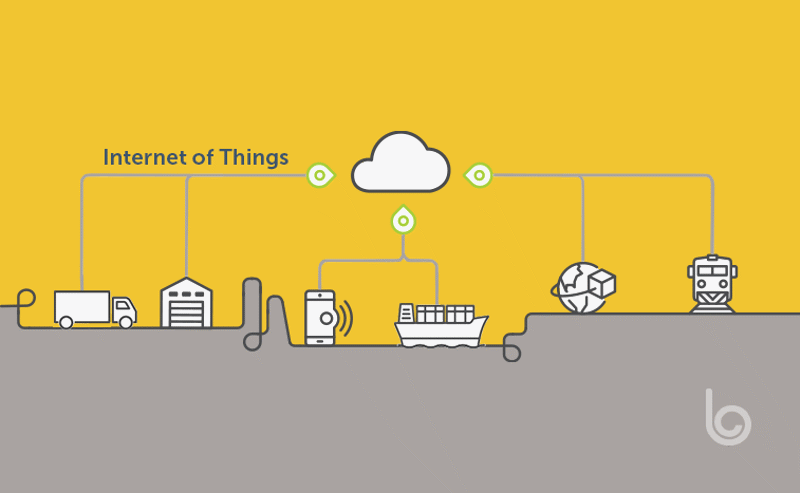The Internet of Things (IoT) is a collection of interconnected physical devices that can monitor, report on and send and exchange data. IoT devices are typically connected to computer systems via data or Wi-Fi networks.
IoT devices use sensors to measure specific aspects of the world around them, including location, temperature, humidity, light levels, movement, handling, speed of movement and other environmental factors. IoT devices come in many form factors including RFID chips, smart devices and mobile sensors.
In the supply chain, Internet of Things devices are an effective way to track and authenticate products and shipments using GPS and other technologies. They can also monitor the storage conditions of products which enhances quality management throughout the supply chain.
How the Internet of Things Relates to the Supply Chain
IoT devices have revolutionized supply chain management (SCM). It’s much easier to understand where goods are, how they are being stored and when they can be expected at a specific location.
Authenticate the Location of Goods at Any Time
IoT devices can be attached to specific storage containers or to raw materials or products themselves. The IoT device will transmit its location, which can be picked up by GPS satellites and used to track movement of goods.
Track Speed of Movement and When Goods Will Arrive
Tracking speed of movement and the traffic flow of products makes it much easier to predict how goods will move through the supply chain. Suppliers, manufacturers and distribution centers can prepare to receive goods, which reduces handling times and ensures the efficient processing of materials.
Monitor Storage Conditions of Raw Materials and Products
Some goods like food and chemicals need to be stored in ideal conditions. Specialist IoT devices can monitor areas like temperature, humidity, exposure to an atmosphere, light intensity and other environmental factors. These devices may even trigger an alarm if certain thresholds are breached. This makes it much easier to track the quality of goods through the supply chain and to reduce spoilage.
Streamline the Problematic Movement of Goods
Goods tracking and route planning through IoT devices can identify where and when goods are delayed in transit. This allows for contingency planning and alternative routes to speed up the supply chain.
Locate Goods in Storage
Goods can remain tagged with IoT devices when they are in a distribution center. This can make it much easier to find specific products within a large warehouse and ensures accurate identification and management of goods.
Administer Goods Immediately Upon Receipt
Verified tracking through IoT devices means that SCM can validate exactly when goods arrive. This can trigger other administrative tasks like supplier payments or onward shipping requests.
Real-time tracking of goods in the supply chain with Blume Global
Why the Internet of Things Matters to the Supply Chain
IoT devices are a major benefit for all aspects of supply chain management:
- Reassurance that goods are located where stakeholders say they are, both at rest and in motion
- Early identification of issues with goods getting lost or delayed
- Real-time shipment and inventory visibility and tracking
- Easier supply and demand planning as stakeholders know when they can expect to receive and process goods
- Better quality management due to keeping raw materials and processed goods in optimal conditions
- Efficient storage and distribution of products due to the easier location of goods in warehouses
How Blume Global is transforming supply chain management
The Challenges of Using the Internet of Things in the Supply Chain
IoT devices rely on good network connectivity to function well. They need to be able to transmit their positions to GPS satellites and other types of IoT devices may require Wi-Fi, Bluetooth or other connectivity. They will not function as effectively in areas with lots of electrical or radio frequency interference.
IoT devices also rely on being installed and powered properly. They should only be handled, attached or removed by trained people. It’s also important to use the right IoT device for the right job, as they can easily be damaged if they’re not used correctly.
Use Cases for the Internet of Things in Retail and Manufacturing Supply Chains
- Farmers can use IoT devices to monitor soil moisture and decide the optimum time to plant or harvest.
- Manufacturers can use IoT-enabled cameras to spot defects and reject faulty products.
- Chemical manufacturers can ensure that raw materials stay safe by monitoring and triggering an alarm if they’re exposed to high temperatures.
- Manufacturers can take advantage of “just-in-time” manufacturing by preparing to produce goods just as they’re scheduled to arrive.
- Food retailers can monitor the temperature and humidity of goods in storage to ensure they reach stores in optimum condition.
- Retailers can work with specialist logistics fleets to track products as they’re en route to distribution centers.
contact us
Contact Us

